Feature
 With an overpowering coastal Asian cultural identity, the experiences of Asian Americans who grew up in the South and Midwest are often overlooked.
With an overpowering coastal Asian cultural identity, the experiences of Asian Americans who grew up in the South and Midwest are often overlooked.
Published August 1, 2019
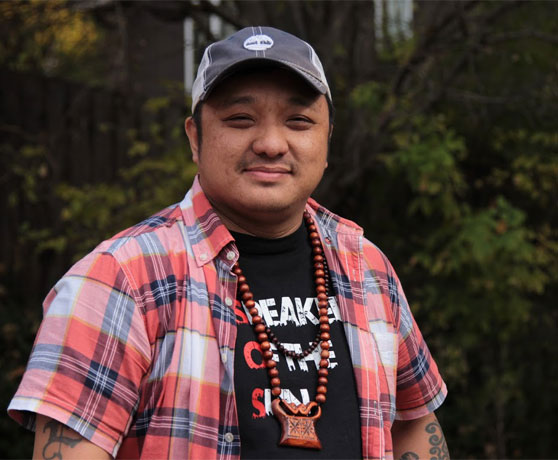
Tou SaiKo Lee poses for a photo in St. Paul, Minnesota. Photo credit: Kevin Yang.
Den Nguyen was drenched in sweat as he sprinted from tent to tent carrying plastic-wrapped trays of xoi vo (mung bean sticky rice) and banh bo nuong (honeycomb cake). The 59-year-old operated a dessert tent for the Vietnamese night market in Dallas that Friday evening. His daughter, Linda, worked the cash register.
“My father has been a scout leader for roughly 20 years,” Linda said, referring to their Catholic church’s scout group. “He was a scout back in Phan Thiet, a coastal city in Southeast Vietnam, ever since he was a child. When he immigrated to Texas, he helped create a chapter. It’s a small, tight-knit group, but one that means the world to him.”
Most vendors represented versions of Nguyen’s scout troop. Members of Chùa Đạo Quang Buddhist temple sold steamed banana and cassava cakes. A local Vietnamese bubble tea cafe provided batches of honey kumquat green tea. At the peak of the night, there were just 12 tents and a small center stage, where traditional Vietnamese tunes crackle from the speakers. A group of roughly 80 people dance together as the sun sets. It’s a modest number for an area with more than 53,000 Vietnamese immigrants, according to the Migration Policy Institute.
But size is the least of their worries. Linda said Vietnamese Texans find comfort in merely existing together as they quietly carry out their lives in a Dallas suburb.
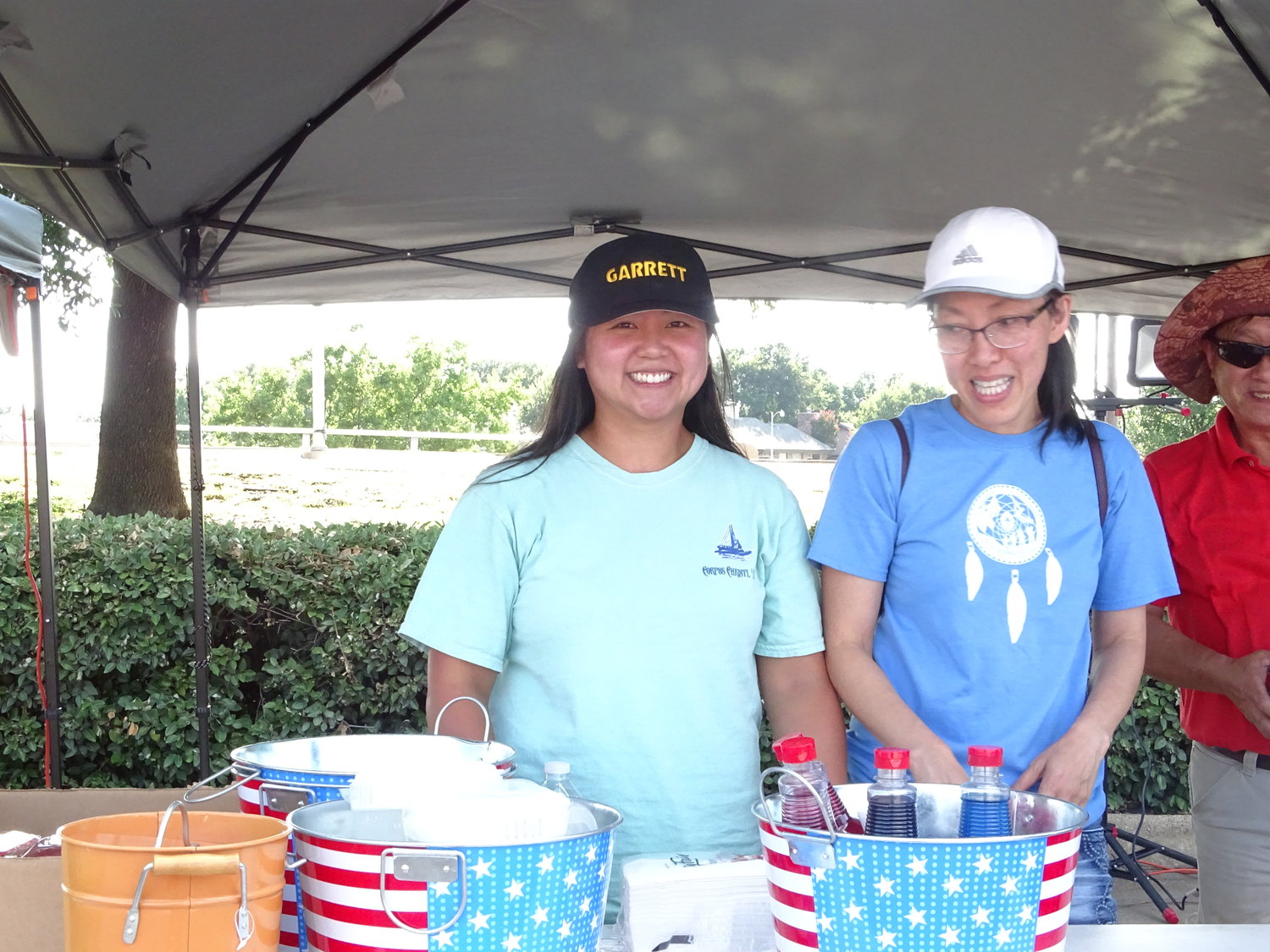
“Today, I’m here with my Vietnamese scout group. My father has been a Den Leader for roughly 20 years. He was in a scout back in Phan Thiet, a coastal city in Southeast Vietnam, ever since he was a child. When he immigrated to Texas, he helped create a chapter. My Dad’s name is actually Den, so I guess he was meant to be a Den leader.” – Lisa Nguyen, 27.
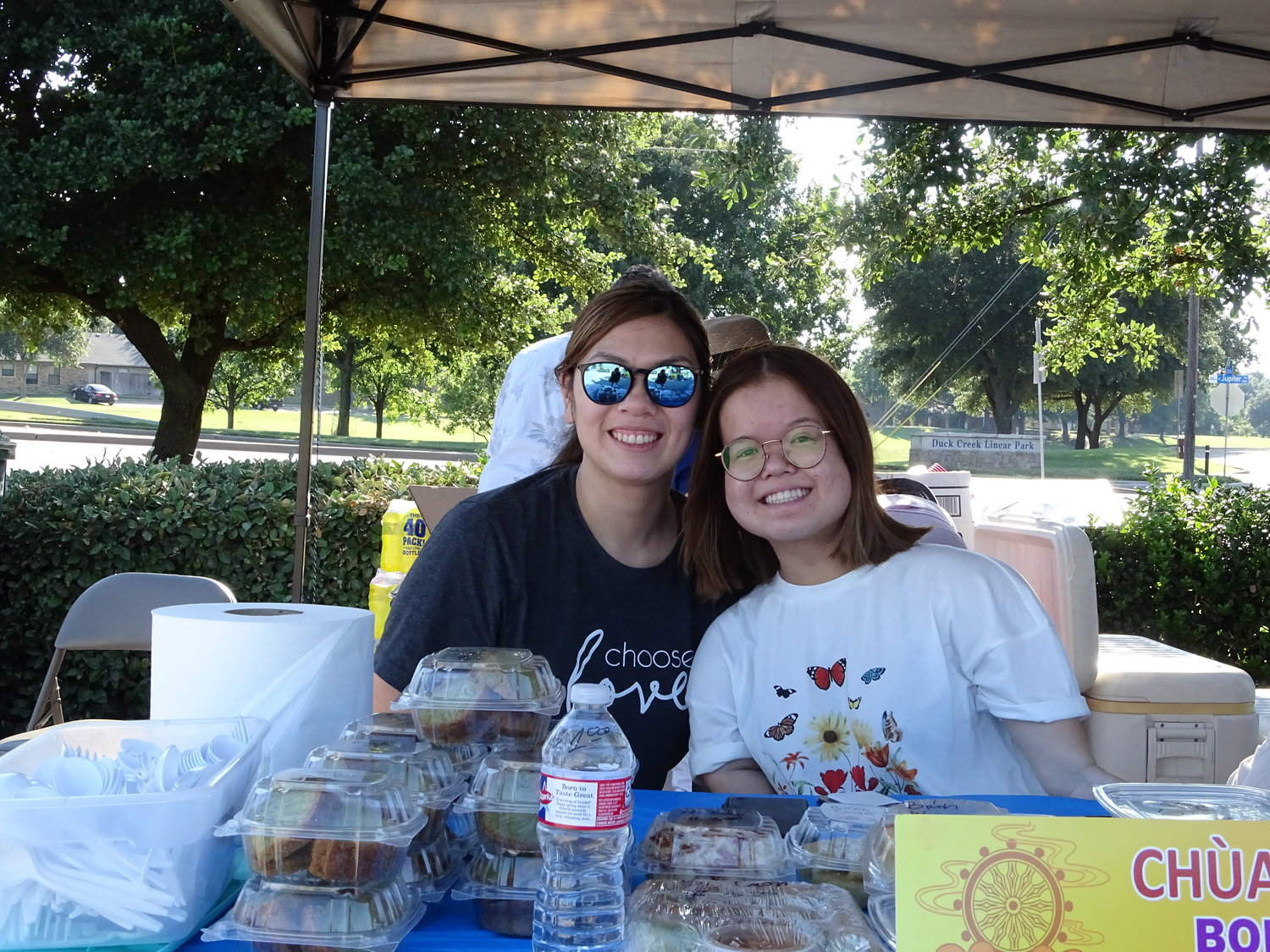
“I think people assume that Vietnamese people are rude. Maybe it’s because of how the language can come off as brash, but I’m proud of it. Speaking it and being able to understand it.” – Ashley Quach, 20 (right)
“People ask me, ‘do you hate us Americans for fighting in the Vietnam War?’ I dated a white guy in the past, and it was also one of the first questions he brought up. They wonder if I still hold a grudge, but we don’t. It doesn’t even really cross the minds of people from younger generations.” – Nhi Huynh, 30 (left)
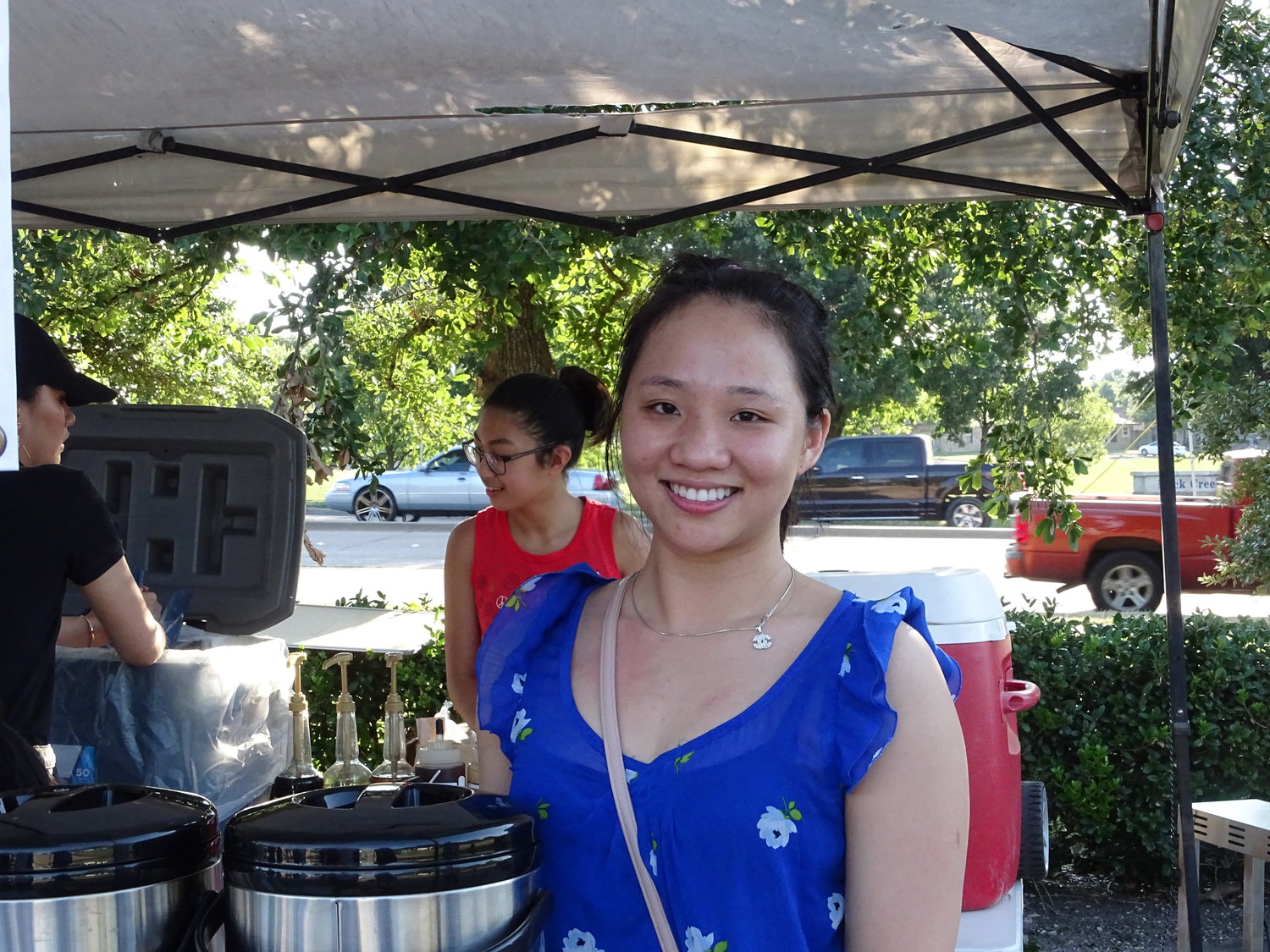
“People think that for Vietnamese food, there is only egg roll, spring roll and pho. My parents were born in Hue, and their city’s food is known as bun bo hue which is a spicy beef soup. None of the soups here taste the same as the noodle in my hometown. It’s because the food here is mainly preserved, whereas at home, it’s cooked as we eat. They will make the broth at three or four in the morning, because everyone ate bun and pho for breakfast. We barely ate it for dinner, and would only eat it sometimes for lunch if we had leftovers from breakfast. You find it in each person’s home, because most households had businesses outside of their house for neighbors to buy. Many families cooked to survive and make ends meet.” – Truong Thi Quynh Mai, 25.
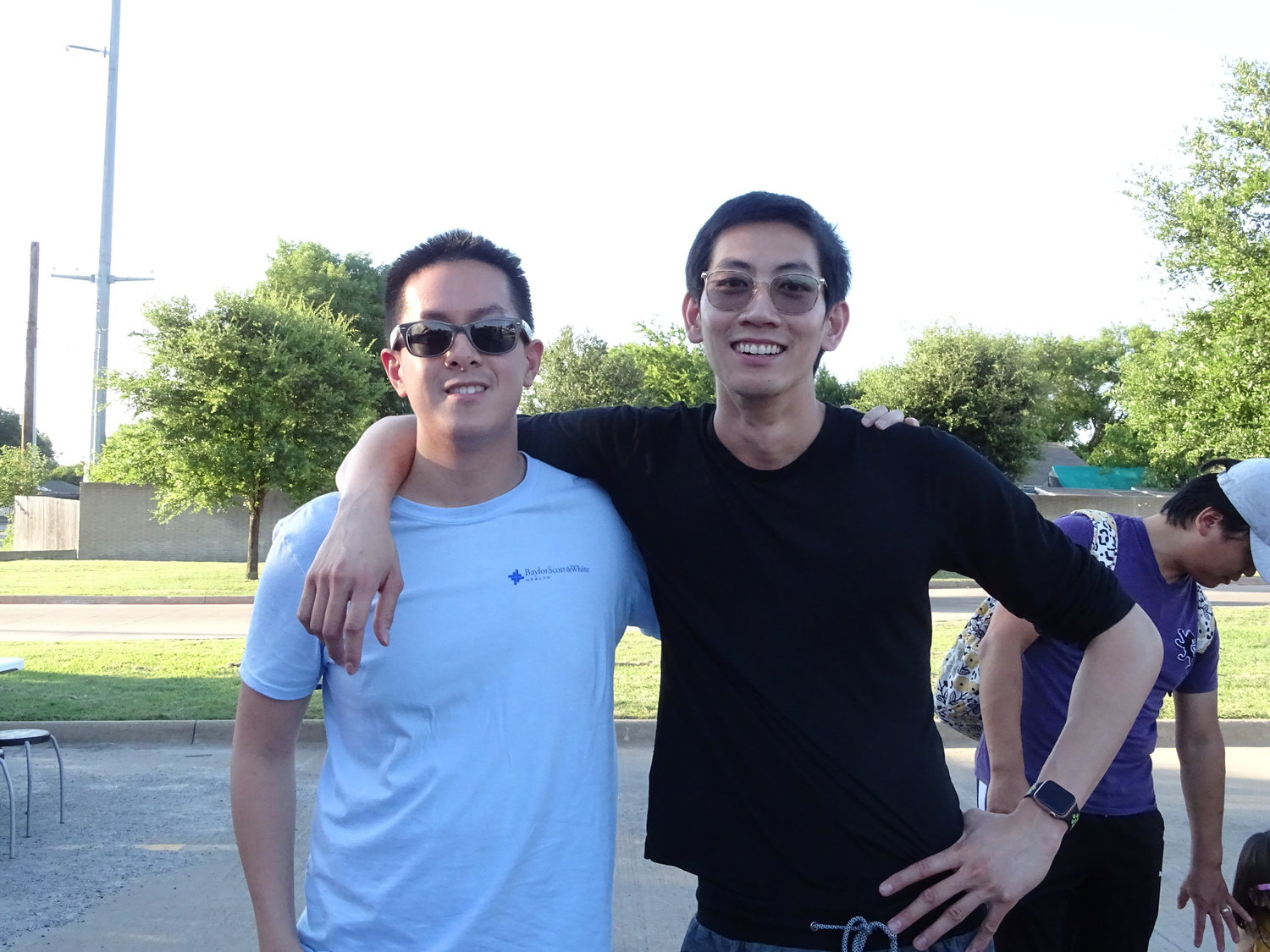
“I think there was an Ali Wong segment where she said we were ‘jungle Asians.’ You know, the Koreans. They’re the ‘pretty Asians’ and then you have us. It’s comedy, I get it, but sometimes I think that people are actually going to start seeing and believing it.” – Alex Dinh, 29 (left)
“Yeah, we’re not all jungle Asians. Our culture is very family-oriented. There’s actually a lot of shame surrounding divorce and pressure to keep the generational structure together. That’s changing with the new generation though, and we’re starting to prioritize our happiness.” – Jay Tran, 29 (right)
“Not many people know that there is such a big Vietnamese community in the South,” Linda said. “I think it’s because our parents like to stay close together. It feels safe.”
With an overpowering coastal Asian cultural identity, the experiences of Asian Americans who grew up in the South and Midwest are often overlooked. In mainstream media, the Asian-American narrative often splits into a binary comparing the East and West coasts. In 2015, the Fung Bros, a Chinese-American brother duo, posted a Youtube video humorously discussing comparisons between the two groups, attracting more than 1.2 million views. The four hosts in the video, all pale-skinned and East Asian, generalized East coast Asians using the term “yappie,” or young Asian professional. They then associated West coast Asians with “AZN culture” — activities like breakdancing, raving and Instagram modeling.
The earliest wave of Asian immigrants arrived by boat. Today, the most notable Asian Americans in pop culture traditionally hail from the coasts — from comedian Hasan Minhaj, who was born in Davis, California, to 2020 presidential candidate Andrew Yang, who grew up in New York.
Meanwhile, underrepresented Asian ethnic groups from the South and Midwest experience the plight of being a double minority: living among a primarily white population while being overshadowed by an East Asian hegemony. These minorities, identified by historian Huping Ling in Emerging Voices: Experiences of Underrepresented Asian Americans, include the Hmong and Mong, the Lowland Lao, Burmese, Indonesians, Thai, Tibetans, Kashmiri, and Roma. They are marginalized in nearly every sense — ethnically, economically, politically, demographically and academically — in both their homelands and in the United States.
Yet these communities encompass what Asian America is today: a rich landscape packed with varying cultures.

Tou SaiKo Lee poses for a photo in St. Paul, Minnesota. Photo credit: Kevin Yang.
Tou SaiKo Lee raised his tattooed arm, pointing down the streets of his hometown. He reminisced on a now-defunct Burger King, digging up violent memories from his youth.
As a teenager in an area plagued with gangs, Lee was swept up in the violence. During this particular incident at the fast food restaurant, a fight between gangs landed him in a juvenile detention center.
“At the time with a lot of the immigrants’ stories, they had trouble fitting in,” Lee said. “They felt discriminated, which led to young people creating gangs. Eventually, you get caught up in the gangs. Those are the only friends you can find.”
Worried for his future and stuck in solitude, Lee turned to hip hop, the foundation of his life for the past two decades. The Hmong rapper, based out of the Twin Cities, used his life in music to escape gang violence. He writes verses to connect with his culture and heritage, which also explains why his tattoos display traditional Hmong scripture.
The Hmong community in Minnesota’s Twin Cities area is one of the largest in the nation, with roughly 70,000 immigrants, according to expert Lee Pao Xiong of the Hmong Studies department at Concordia University. The Hmong have two distinct festivals throughout the year in the area: the Hmong Freedom Festival and the Hmong New Year. Despite internal differences, whether they be religion, lifestyle or other aspects, they congregate to celebrate. When the Hmong escaped from Laos to refugee camps across the world, “home” became a foreign concept.
For the Hmong people, oral traditions are a significant part of their identity. On the whole, their history these past few decades remains unwritten, though that’s changed in recent years.
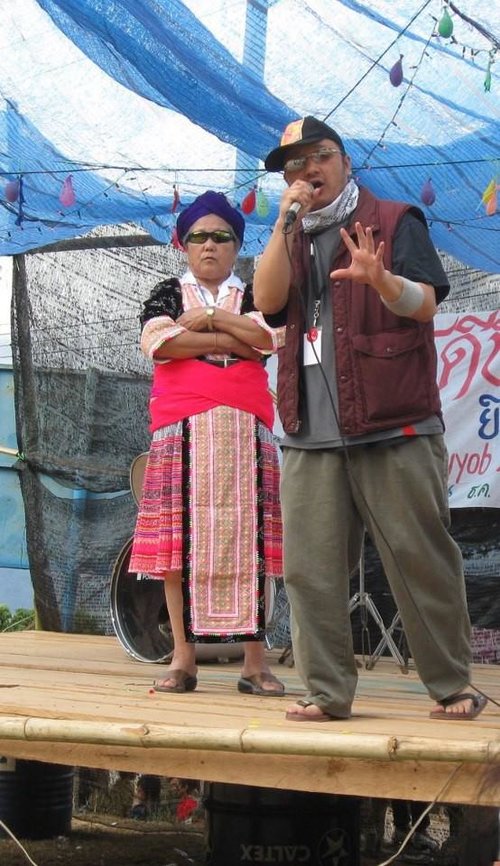
Tou SaiKo Lee raps while his grandma, Youa Chang, stands in teh background in Phu Chi Fa Mountain, Thailand. Photo credit: Phas Vwj.
When Lee first stumbled into rap, he was attempting to connect to the wider American community. That changed when his grandma, Youa Chang, immigrated to the United States. At first, Lee and Chang struggled to bond; Lee knew little about Hmong culture and Chang was illiterate. Eventually, Lee learned more about his heritage through his grandmother, just like thousands of other Hmong people. The duo connected more once Lee understood kwv txhiaj, traditional Hmong poetry chanting.
“All she knew was oral tradition,” Lee said. “I started to get really fascinated with what grandma was doing.”
Chang performed poems in front of crowds — just like Lee during his hip hop shows. She memorized verses the night before, reciting them perfectly as intended the next day. Lee called it an “enhanced sense of memorization,” because he didn’t understand how his grandma could remember so much so quickly.
After linking similarities between her poetry chanting and his rap performances, he asked his grandma to collaborate for shows. His connection with his grandma made him realize how crucial his Hmong heritage was to him. What was once an effort to connect with mainstream America ended with Lee intimately bonding with his culture.
“I see that connection between kwv txhiaj and her oral tradition to what I’m doing now with spoken word poetry and hip hop,” Lee said. “I also saw her improvise poetry because she actually did this poem where she gave a shout out to St. Paul. She improvised that, so I was like, ‘My grandma freestyles.’ Then I understood better that it was oral tradition.”
Later in his career, Lee transitioned to rapping in Hmong. He originally relied on his cousins to translate the English verses. After long hours and practice, he wrote his own lyrics, though his parents double-check for any errors. Some elders even poked fun at him, saying his Hmong is fluid when rapping but choppy while speaking in conversation.
Today, Lee resides within the Frogtown neighborhood of St. Paul, Minnesota, and works with the neighborhood association. He said he creates after school programs and other activities to keep kids out of trouble, just like his teenage self.
Being Hmong is a vital part of Lee’s identity. When he traveled to Thailand, China and Vietnam in 2008, he realized his people’s stature. He was inked with his tattoos during that trip. The symbols originate from an old Hmong dialect, before Roman influences altered the language to its current state. Lee learned only about 20 people in the world understand it.
During that trip, he made the comparison of Hmong people to Native Americans in the U.S., as neither group has a “home” to return to. They’re just ethnic groups within specific countries, Lee explained, spread across the world.
That’s why Lee tries to represent his culture — one verse at a time.
“Hmong is a minority within a minority, meaning that we’re just an ethnic group within the Asian race,” Lee said. “They don’t have a country. They have to find other ways to maintain their cultural identity and their traditions.”
St. Paul East Sider Mai Vang isn’t your typical housewife. Every morning, she wakes up at the crack of dawn, gets in her inconspicuous sedan and immerses herself into her latest favorite anime fan fiction as her husband Chai Xiong drives her across town so she can fry up crisp, golden eggrolls by the dozens.
Mai spent her childhood in a Thai refugee camp and moved to the United States when she was eight. Although it’s been more than 30 years, she still remembers her parents’ stories about the Hmong people in Thailand.
“We are at that age that we know about our own culture,” Mai said, comparing her cultural literacy to third- and fourth-generation Hmong Americans. “At camp, during the day, we play and at night, parents tell a story about the old day, how they come around. How did they live life — story passed down, you know?”
Back in Southeast Asia, the Hmong lived in villages organized by 18 clans; those from the same clan have the same last name. When they arrived in the Midwest, they mimicked their clan villages by moving closer to extended family. As a result, Mai and her husband grew up together, living amongst their extended family in Wisconsin, then Minnesota.
One winter morning, their whole world came crashing down.
Expecting to hear the clicking of her youngest son Kounew playing video games and the sizzling of her oldest son Kevin frying breakfast, she woke up to a chilly, piercing silence. In the subsequent week, doctors confirmed her worst fear — she had gone deaf.
“It was so hard. We used to be a family that had very good relationship. We went to screaming at her because in our heart, we wanted her to hear,” Chai sighed.
Currently, a cochlear implant without health insurance costs $50,000. One day, when she can afford better technology, Mai hopes to regain her hearing. Chai and their four sons — Kevin, Kyle, Yingkong and Kounew — now communicate with her via writing.
Often found pulled up next to the State Capitol curb or in downtown Rice Park, Eggroll Queen is Mai’s livelihood on wheels, a food truck that derived its name from the moniker St. Paul East Siders gave her for donating home cooked eggrolls to local causes. The 40 year-old St. Paul transplant started the business out of her own kitchen in 2014, imitating the recipe her mother taught her when she was a young girl.
“Life was more fun in the camp as a kid,” Mai said, describing her childhood. “It’s not good for the elder, because they feel like they are caged in, they feel like they’re prisoner … but for the kids, fun because you can see a friend. But here [in America], everybody just go to school, come home, watch TV, or do homework. That’s pretty much it, all day.”
After she went deaf, Mai grew more desolate. During the cold winter months, as she sat at home alone, she often thought about killing herself. She unloaded dark suicidal thoughts of jumping off a bridge onto Chai when he came back from work.
“When I go deaf, I feel really useless. I feel like I couldn’t contribute to anything, to my family, or to anyone,” she said, her voice dropping lower as she read questions typed out over Facebook Messenger.
Lonely and lost, she stumbled on an eye-catching post one day while scrolling through Facebook. Mai read about the Yang family and their daughter, who died in a house fire. The Yang’s grandmother died shortly afterwards. Though Mai hardly knew the family, she quickly fried up a batch of eggrolls and showed up on their doorstep, offering to sell them to the neighborhood so the Yangs could cover some expenses while rebuilding from the ground up.
She found helping people lifted her spirits. She became known as the generous East Side “Eggroll Queen” because of her prolific fundraising efforts. As demand grew, Mai decided to move her eggroll operation and sales into a food truck embellished with giant eggrolls.
“Without it, I think I may have commit suicide already. I think cooking and trying to make great eggrolls save me,” she said.
Eggroll Queen is under expansion and now has a brick and mortar shop called Underground Music Cafe which serves up an eclectic menu of fire-wood pizza, wine — and, of course, eggrolls.
“I used to have more passion when I was younger. But now I don’t anymore. Pretty much just wake up, do eggroll, and go to sleep,” Mai laughed.
“Growing up, my dad told me to trust no one and that no one was really my friend,” Bryant Dang said.
As the firstborn son in his family, the 21-year-old was raised under intense pressure to succeed to honor his grandfather, a lieutenant colonel in the Army of the Republic of Vietnam. He was confined as a prisoner of war for 13 years.
For most of their childhood, Bryant and his younger brother Kevin lived in Oklahoma City, where they were often the only Asian students in class. Their father raised them with a firm grip, instructing both sons to come straight home after school and keep their heads down.
“It was always a fight to survive and get above other people,” Bryant said. “He never realized there are other people. His entire life was by himself struggling.”
Though Bryant and Kevin learned at an early age to respect stories of Vietnam, establishing a personal connection between those family narratives and their identities as Vietnamese Americans was difficult.
“I was a ‘redneck Asian’ in elementary school,” Bryant said. “Growing up as one of two Asian kids in my class, I wanted to do things like participate in a rodeo and drive a monster truck. Football seemed like the one activity that would elevate me from ‘that Asian kid’ to someone more memorable.”
Instead of being “that Asian kid” on the football team, Kevin was “that choir kid.”
“I would obnoxiously skip up and down the hallway singing,” Kevin said. “When I sing, I felt like I could unleash and express what I was feeling. It helped me find confidence in vulnerability.”
Both brothers found temporary comfort securing a group of friends, but felt the pressure to put on a persona. Bryant never liked football and was often the victim of racially targeted jokes, like being coerced to imitate Asian accents by his teammates. He stayed until his senior year, though, leaning into the toughness that his dad reinforced.
“My dad tried to raise me to be very proud, but I ended up being the exact opposite: socially awkward and shy,” Bryant said. “I saw my dad in myself and tried to break out of the ideals he enforced in me. But there was just so much of him in me.”
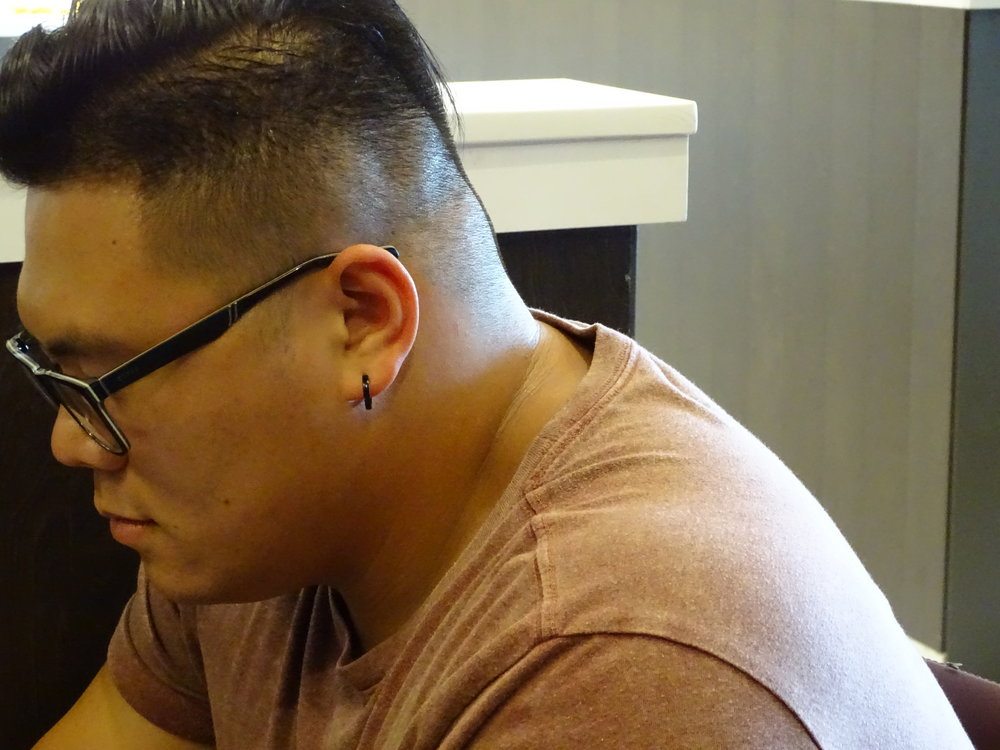
Photo credit: Grace Moon. “A lot of us grew up as the stereotypical Asian kid. But the Asian Americans we saw on Youtube were different. They were cool and seemed so comfortable in their own skin. I feel like Asian kids from small towns never really had the chance to break out of their comfort zone.”
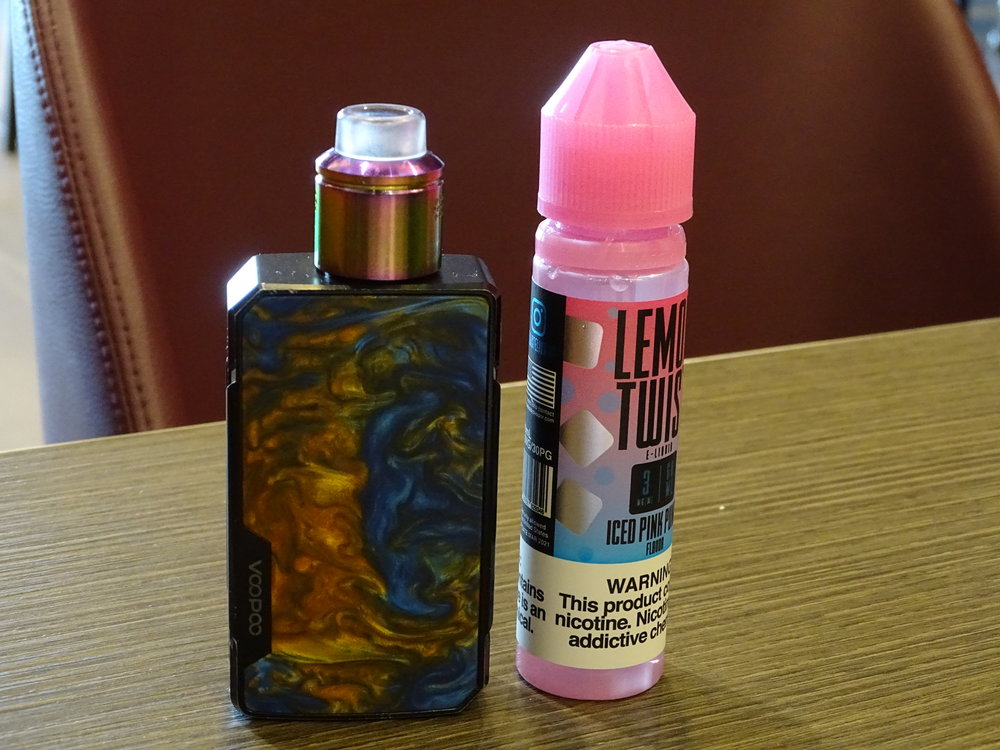
Photo credit: Grace Moon. “Like, look at me. My vape, NMD shoes, piercings. We start to mimic the things, styles, auras that they see on the Internet.”
Bryant’s first dose of community and inclusion wasn’t until college, when he joined the Vietnamese Student Association (VSA) at the University of Texas at Dallas.
“I remember when a few VSA southern chapters had a get-together,” Bryant said. “The story we all had in common was getting spanked by our parents. Everyone was asking each other if their mom also used the cooking spatula.”
In an attempt to break out of the toxicity of his football experience and look past his dad’s definition of what constituted Vietnamese heritage, Bryant searched for peers online.
Bryant and his VSA friends were among the 1.4 million Facebook users who joined subtle asian traits (SAT), a viral image board for jokes and memes addressing the Asian diaspora. Around November 2018, Bryant was added to a subgroup of SAT called subtle asian dating (SAD) — an online dating group where “members can ‘auction off’ their single friends to others in the closed group.”
“I never came across posts relatable to southern Asians,” Bryant said. “Asian communities in Texas are growing to the point where we’re leveling up with the coastal cities. It’s California, New York and Texas now. Most of the posts centered coastal experiences, so I went ahead and made a subtle asian dating: texas edition just for fun with one of my VSA friends.”
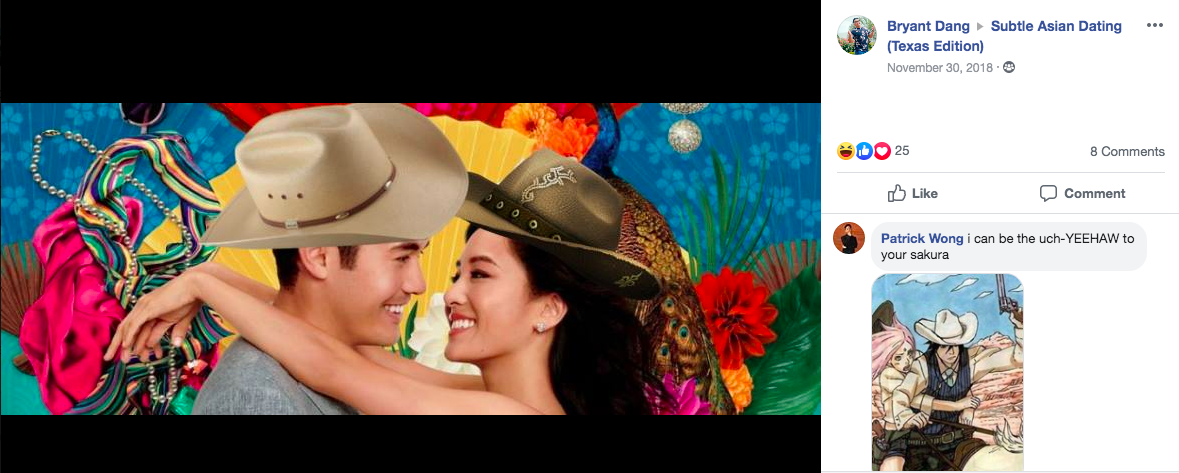
Source: Subtle Asian Dating (Texas Edition)
What started as a group of roughly 200 mutual VSA friends exploded within a few months into a group with over 3,500 members. The posts include jokes about “Ni Haody,” local dating auctions and a call-out for Lao people in the area.
While Bryant started exploring his sub-identity as a southern Asian through both physical and digital communities, Kevin began to wonder if there were other gay, Vietnamese men like himself.
“I kept asking myself, ‘If gayness is an actual thing, then where were all the gays at school? In Dallas?,’” Kevin said. “I needed a physical connection for my emotions to feel genuine. So, I downloaded a dating app.”
When Kevin downloaded Grindr, a dating platform for LGBTQ people, he was 17 and unacquainted with online dating culture.
“There was a thrill inside of me when I saw my (direct messages) bombarded with compliments,” Kevin said. “I had never experienced visibility. It felt good, you know — to be wanted.”
As one of few gay Asian men on the apps, though, much of the attention Kevin attracted was not only unwanted, but also objectifying. He wanted to find a way to define his self-worth on his own terms while putting his sexual and ethnic identities in conversation.
In November 2018, Kevin launched his modeling page in hopes of building an online creative outlet for himself as well as other queer Asians.
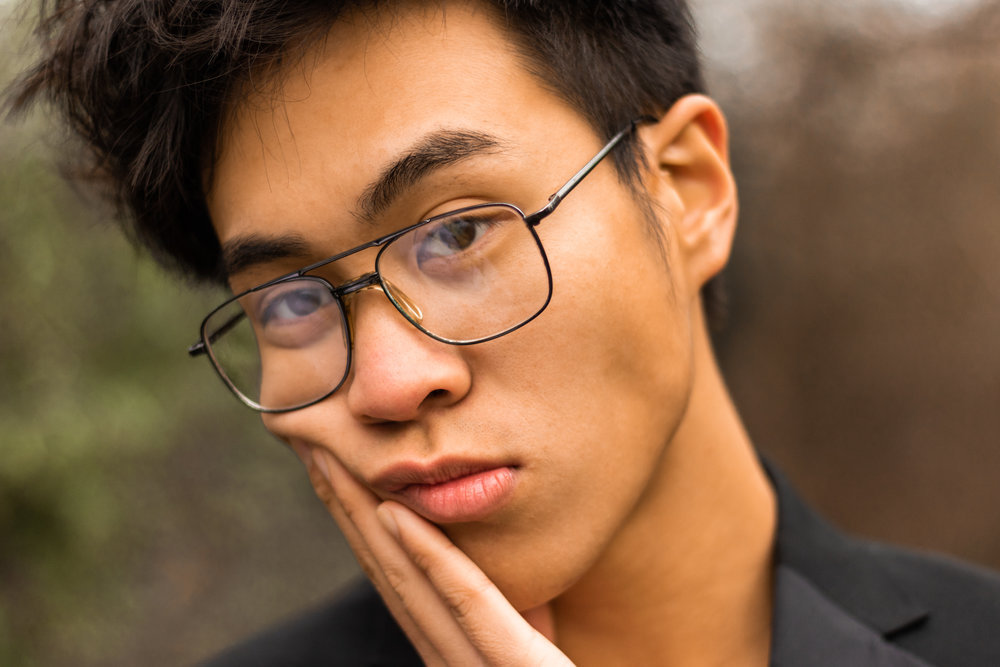
Photo credit: Daniel Mahaffey

Photo credit: Daniel Mahaffey.” This is the picture where for the first time in my life, I felt like I had no flaws. I was genuinely perfect in my own eyes and was in love with myself.”
“When you think of a male body, you think of a very cookie-cutter model with broad shoulders and washboard abs,” Kevin said. “I don’t have those features, and I wanted to portray that I was in love with every inch of it unconditionally.
“I’m already a minority within a minority. Older Vietnamese people in general fly under the radar, and it’s been difficult coming out to them. But I think that both Bryant and I channeled the isolation we felt growing up into our own online communities.”
For many, the Hmong and Vietnamese communities are merely a blip in the United States. Those within the diasporas seek a way to connect with their heritage, with varying degrees of success.
Venture an hour or two out of the Twin Cities and the Hmong people become unknown. Do the same in the Dallas-Fort Worth area and the Vietnamese population fades into the shadow.
Despite their anonymity — and stature as a “minority within a minority” — their stories matter all the same. These communities still face life as a double minority, living in white communities and existing within East Asian normativity.
Tou SaiKo Lee grew to accept those realities, rapping on-stage about his desire to bond with his culture. He doesn’t perform much these days, especially since his grandma died in 2017.
Lee said it took him the past few years to reflect on her death, and he wanted to honor her in some way. The lyricist returned to his days of writing in working towards a memoir about her. The manuscript is done, just some revisions need to be completed.
The title: “My Grandma Can Freestyle.”
Kaitlyn Cheung, Grace Moon, and Souichi Terada are 2019 AAJA Voices Students. Kaitlyn Cheung is a freelance writer and a product designer based in San Francisco. Grace Moon is a freelance writer based in Seoul and a 2019-2020 Princeton-in-Asia fellow. Souichi Terada is a recent graduate of Michigan State University currently working for the Star Tribune. The culture features team was edited by Kris Vera-Phillips and Sameer Rao, Arts and Entertainment Reporter at the Baltimore Sun.
The University of Hong Kong
New York University
Michigan State University
Feature
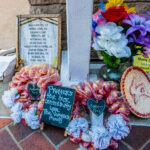
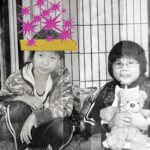


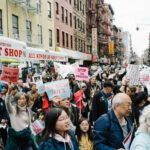
Atlanta 2019

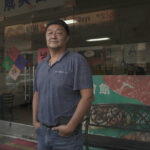
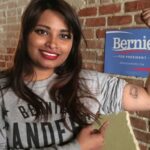
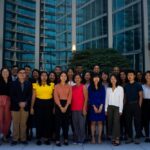
Apply
Become a fellow or editor
Donate
Support our impact
Partner
Work with us as a brand
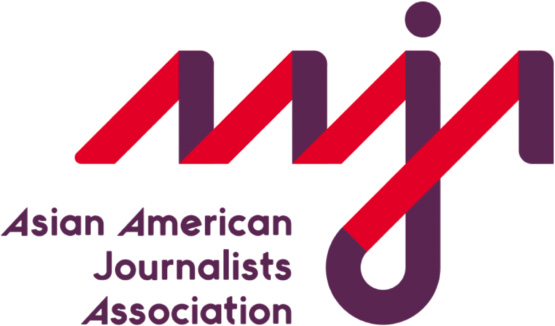
The Asian American Journalists Association (AAJA) is a membership nonprofit advancing diversity in newsrooms and ensuring fair and accurate coverage of communities of color. AAJA has more than 1,500 members across the United States and Asia.